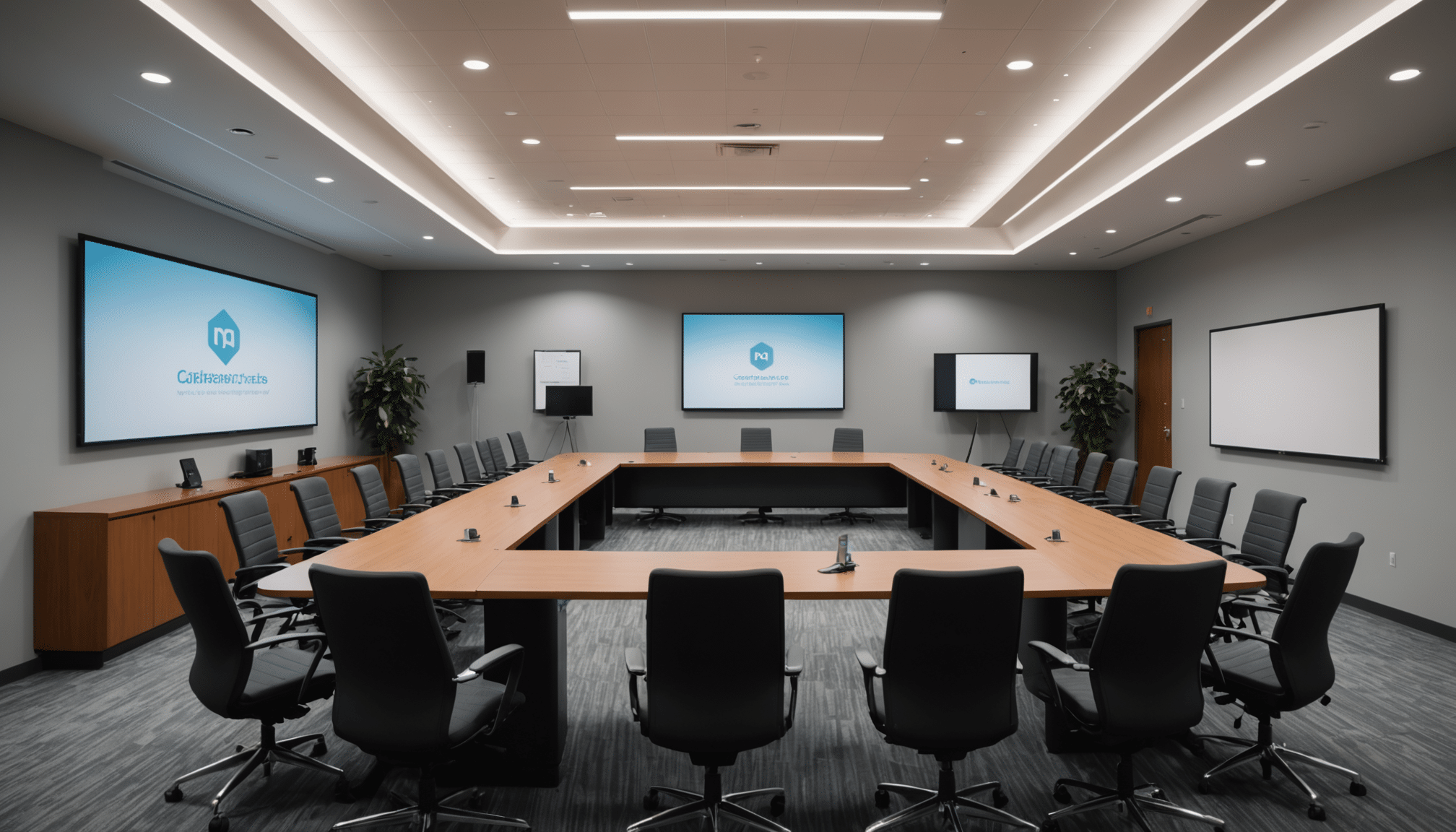
Conference Room Set Up Tips That Actually Work
Discover how to SET UP A MEETING ROOM that boosts PRODUCTIVITY with smart LAYOUT choices, essential TECH and the best TYPES OF MEETING ROOM LAYOUTS explained clearly.
Last Updated on 25/11/2025
A well-planned meeting room setup sets the tone for every discussion, presentation or decision-making moment. From layout and furniture to technology and acoustics, the right choices improve comfort, clarity and collaboration. Whether it’s a boardroom or a hybrid space, thoughtful design helps you create a productive and professional conference room environment.
How do I set up a conference room?
Choose a room layout that fits your meeting type, equip it with quality audio-visual tools, and use comfortable, functional office furniture. Ensure good lighting, sound, and accessibility. For hybrid teams, include video conferencing equipment. Keep the design tidy, professional, and suited to your team’s communication and productivity needs.
Key Tips for Conference Room Setup
- Choose a room layout that suits your meeting goals and encourages participation.
- Invest in reliable video conferencing equipment for smooth hybrid collaboration.
- Use modular desks and furniture for flexibility and reconfiguration.
- Prioritise good acoustics and even lighting to support focus and clarity.
- Include accessible seating and ensure clear pathways for all participants.
- Keep the space tidy with built-in cable management and charging stations.
- Match your style layout to the tone of the meeting—formal or creative.
Choosing the Right Room Layout
Picking the right meeting room layout can be the difference between engaged attendees and wandering minds. Each style layout serves a purpose. The classic boardroom style, with a long table and central focus, works well for decision-making and smaller groups like a Board of Directors. It encourages direct communication but can feel rigid for more interactive sessions.
If you want participants to interact or brainstorm, try a u-shape or hollow square layout. These open designs promote collaboration and give the presenter more space to move. For training sessions or lectures, classroom style keeps attention pointed in one direction while still allowing note-taking.
Need to boost interaction? Go cabaret style. It mixes communication with comfort, placing people around semi-circular tables. Don’t forget accessibility—leave room for wheelchair users and keep exits clear. When in doubt, match your layout to your meeting goals, and you’ll set the stage for real productivity.
Essential Conference Room Equipment
No matter how slick your meeting room layout is, it won’t work without the right tech. Start with reliable conference cameras and stations. These are a must for hybrid teams and remote work setups. Combine them with smart microphones and noise control to keep videotelephony crystal clear and echo-free.
Don’t skimp on screens. A large display or projector boosts engagement—people want to *see* the information, not squint at it. If you’re running Microsoft Teams Rooms, make sure your hardware plays nice with your software. Bonus points for a decent whiteboard for quick visual thinking.
And let’s not forget the humble desk setup. Charging stations, ergonomic chairs, and stable conference tables are all part of the equipment puzzle. You’ll find plenty of conference tables to fit your room design. Keep things tidy, connected, and comfortable—because tech frustration is no one’s idea of a productive morning.
Practical Tips for Room Design
Good conference room design starts with space planning. Don’t cram a huddle of 12 into a broom closet. Consider how your meeting room layout fits the purpose: long sessions need comfort, short huddles need speed. Use office furniture that allows flexibility—modular desks, mobile screens, and adjustable chairs keep your options open.
Lighting and acoustics can quietly make or break your meetings. Too dark, and people doze off. Too bright, and they’ll feel like they’re in an operating room. Aim for soft, even lighting with minimal glare. Acoustic panels help control sound, especially in large office spaces where noise loves to bounce around like an over-caffeinated bean.
Don’t overlook accessibility and occupational safety. Leave enough space for easy movement, include accessible seating, and make sure technology is reachable for everyone. Your meeting room setup should reflect not just style, but thoughtfulness—because great communication thrives in well-designed rooms.
Optimising Meeting Room Setup for Hybrid Teams
Hybrid meetings are here to stay, and so is the awkward “can you hear me now?” moment. To avoid this, design your meeting room layout with both physical and remote participants in mind. Use centre-facing desks or semi-circular layouts to avoid the dreaded back-of-the-head webcam view.
Smart conferencing tech matters more than ever. Invest in integrated Microsoft Teams Rooms systems, noise-cancelling mics, and dynamic cameras that track who’s talking. This keeps remote participants fully engaged instead of feeling like second-class attendees. Bonus: it improves accessibility and productivity across the board.
Hybrid setups also benefit from flexible room layout planning. A movable whiteboard, shared screens, and strong Wi-Fi help maintain a sense of teamwork across physical and virtual walls. When your space supports every type of presence, you make room—literally—for better collaboration.
| Layout Style | Best For | Interaction Level |
|---|---|---|
| Boardroom Style | Formal meetings, Board of Directors | Low |
| U-Shape | Workshops, presentations with interaction | High |
| Hollow Square | Group discussions, brainstorming | Medium |
| Classroom Style | Lectures, training sessions | Low |
| Cabaret Style | Collaborative sessions, informal meetings | High |
Conclusion
Setting up a conference room that truly works isn’t just about layout—it’s about clarity, comfort, and clever use of space. From choosing the right style to integrating smart technology, each decision shapes how teams communicate, collaborate and stay productive throughout the day.
At Viking, we combine years of experience with a passion for workplace solutions to help you create spaces that work smarter. Whether you’re looking to reduce costs, support hybrid working or boost productivity, our office furniture and equipment can help you set up a meeting room that gets results.
Frequently Asked Questions
What is the best layout for a meeting room?
The ideal meeting room layout depends on your goals. Boardroom style works well for formal discussions and decision-making, while u-shape or cabaret style supports interaction and brainstorming. Classroom style suits lectures or training sessions. Choose a room layout that enhances communication, supports the presenter, and fits the size of your team.
What equipment is essential in a conference room setup?
A well-equipped conference room should include a display screen or projector, video conferencing tools, a reliable audio system, and a whiteboard for notes. Good lighting, proper acoustics, and accessible furniture are equally important. These elements support hybrid work, reduce noise distractions, and boost the productivity of in-person and remote teams alike.
How can I improve meeting room productivity?
Start with a clutter-free, functional room layout that suits the meeting’s purpose. Use ergonomic furniture and ensure tech like videotelephony software is seamless. A good presenter setup, noise control, and natural light all help maintain attention and creativity. Managing time, communication flow, and comfort are key to boosting overall productivity.
Does room shape affect conference room acoustics?
Yes, the shape and design of your room can significantly impact acoustics. Square or rectangular rooms often create sound bounce, especially if left bare. Rounded corners, soft surfaces, and sound-absorbing materials help reduce echo and noise. These adjustments are vital for clear communication, particularly during hybrid meetings or video conferencing calls.






